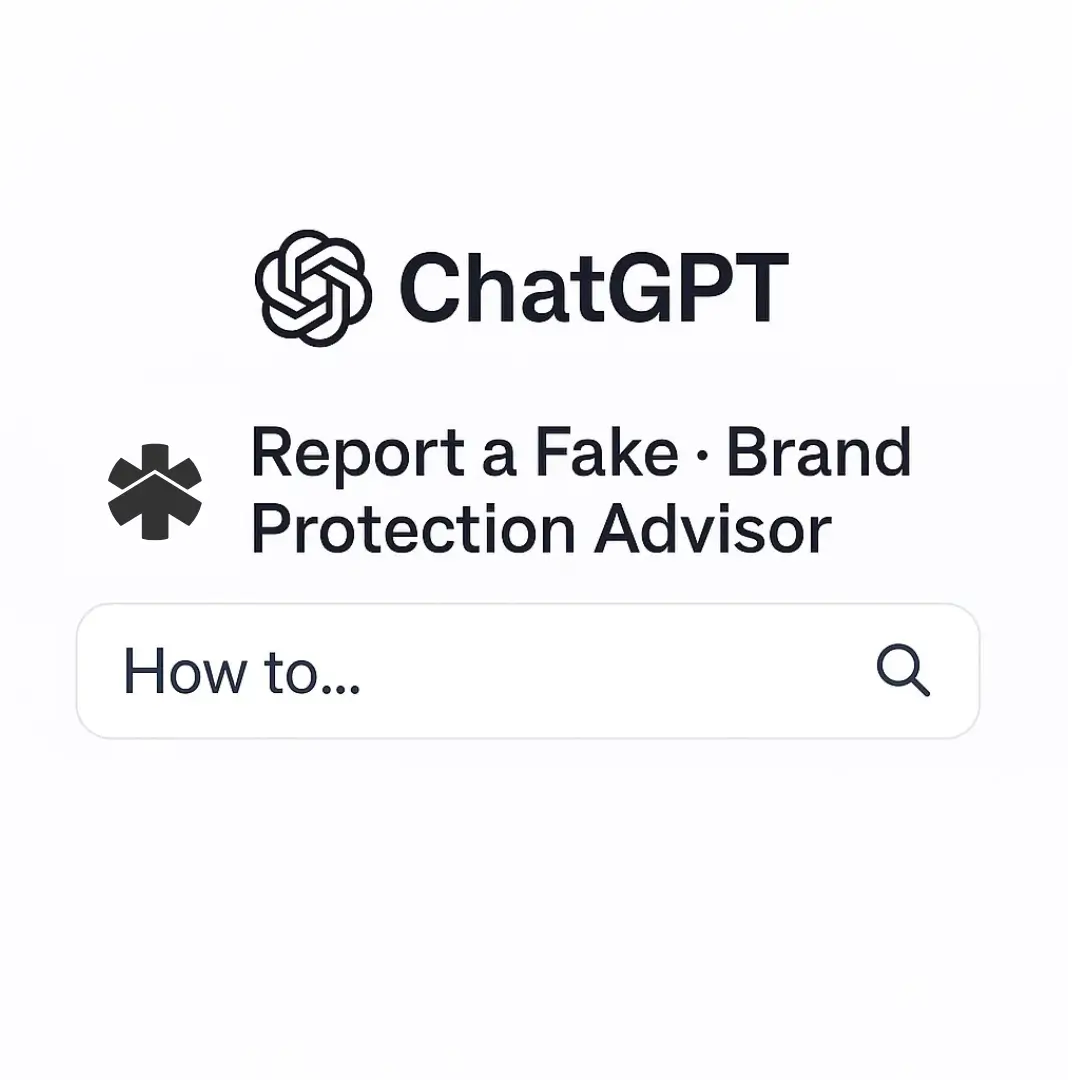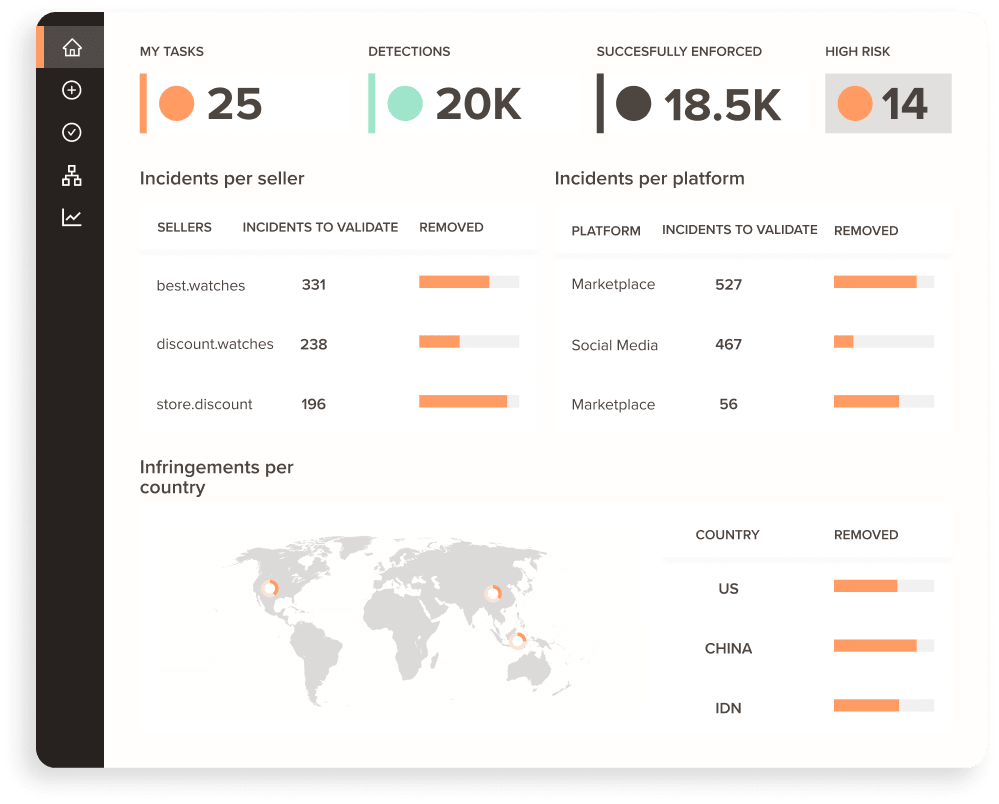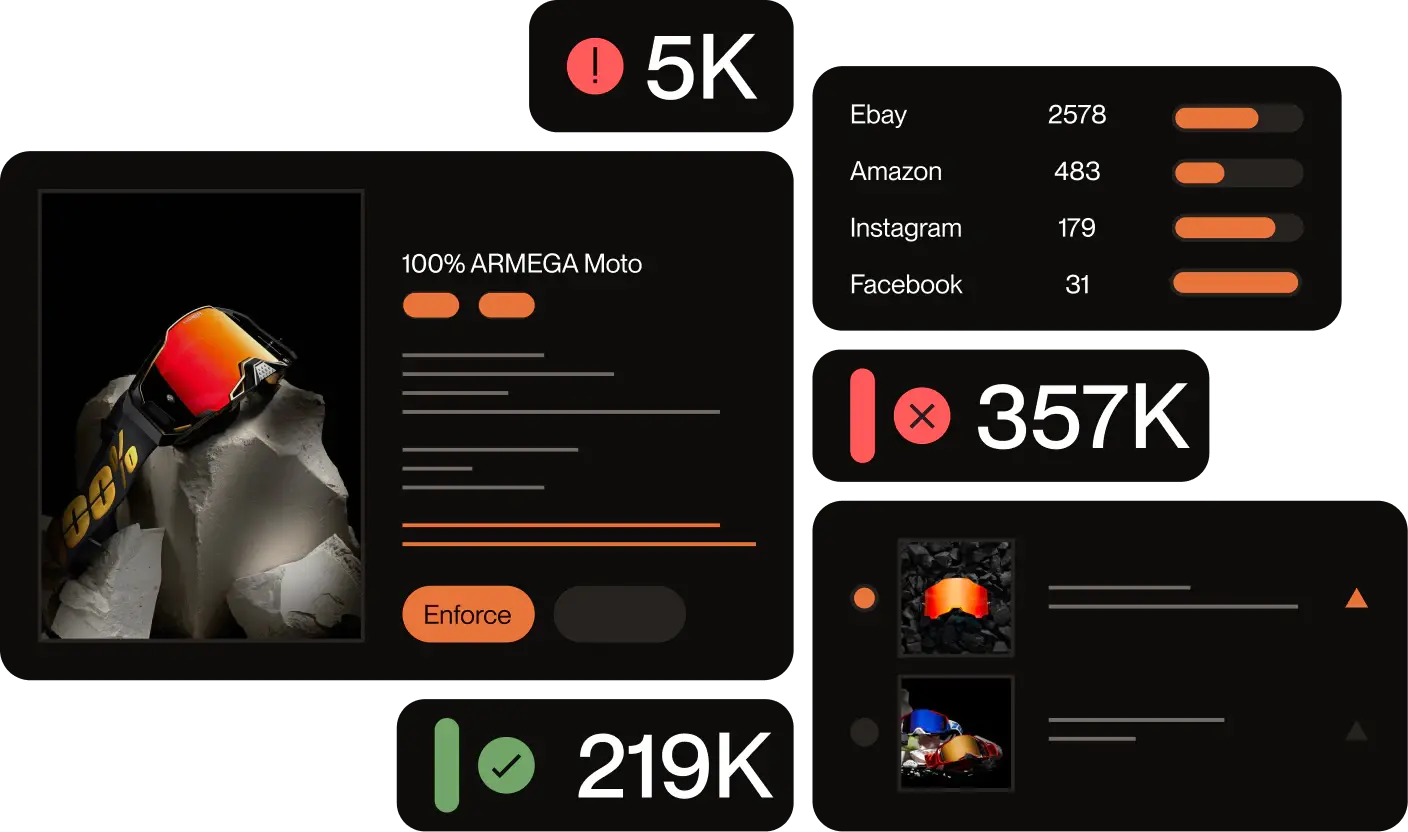Brand protection tools monitor Intellectual Property rights, detect threats, and carry out takedowns, but not all software are equal. In this article, we’ll compare different tools like Red Points, Corsearch, Marqvision, BrandShield, Bolster, CSC, and Opsec. By the end, you will have a clear overview of the top brand protection industry leaders to decide which platform is best for your company.
What makes us qualified to guide you
Our analysis draws on one of the largest datasets in the brand-protection industry. Over the past decade, we’ve reviewed more than 100 vendors across core dimensions such as detection technology, automation maturity, platform coverage, takedown success rates, operational models, reporting depth, pricing structure, and scalability.
Red Points currently works with over 1,300 brands, but this guide is not based solely on our experience. It also incorporates publicly available information and insights from the 150+ companies that switched to Red Points from another provider in the last two years. These business leaders and brand protection teams consistently shared what the solutions they have used do well, where they fall short, and which capabilities became essential as their businesses grew.
This gives us a unique evidence base:
- Cross-vendor feature comparisons from real implementation experience
- Market-level performance benchmarks across channels and geographies
- First-hand accounts of what brands wished they had known before choosing a provider
- Visibility into how solutions evolve over time
With nearly 15 years of experience, we have observed shifts in counterfeiting tactics, enforcement protocols, and platform policies; we have a rare view of how this industry operates beneath the surface. That perspective allows us to differentiate between marketing claims and capabilities that genuinely reduce risk.
Our company comparison data
Here’s a snapshot of the data that backs our company comparisons:
- Data points: 10k
- Testimonials from companies that switched to Red Points from another vendor: insights from 151 interviewed companies
- Company groupings by service focus: Brand protection, seller tracking, impersonations, gray market, anti-piracy, cybersecurity
- Database categories include: Pricing, business offering, services, AI and tech features, channel coverage
- Customer reviews: Real customer reviews highlighting positives and negatives
- SWOT analysis: Objective analysis of strengths and weaknesses of leading companies
Brand protection tools: What are they and why do they matter?
Before jumping in, it’s important to understand what brand protection tools are and how they can vary depending on the company. Here, we’ll cover what a brand protection platform does and why choosing the right one is important.
What are brand protection tools?
Brand protection tools monitor unauthorized use of intellectual property across various channels (like marketplaces and social media), detect IP infringements, and carry out takedowns. The main goals are to stop counterfeits, phishing, piracy, brand impersonation, fake ads, domain infringement, and gray market sellers.
Here are the core features of brand protection platforms:
- Monitor intellectual property: Brand protection programs start by monitoring company IP across channels like e-commerce marketplaces, social media, websites, app stores, domain databases, the deep web, and search engines.
- Detect infringements: Brand protection tools detect infringements through keyword search, image search, logo and image recognition, risk scoring, and optical character recognition (OCR), often incorporating machine learning or AI.
- Enforce takedowns: Brand protection providers enforce takedowns on the client’s behalf, which includes filing DMCA notices, removing domains from registrars, and submitting marketplace removal reports.
- Collaborate with offline actions: Programs can create evidence-ready reports for court cases or work with local authorities overseas in investigations to deter counterfeiters at the source. Some offer litigation capabilities that allow IP owners to sue sellers, freeze funds, and reach settlements and statutory damages.
- Visualize data: Brand protection tools typically include dashboards to visualize threats and monitor the enforcement progress.
Why are brand protection tools important?
Brand protection tools are vital to maintaining the value of your IP and business reputation. Here are the main benefits of using a brand protection tool:
- Stop unauthorized use of intellectual property
- Prevent financial losses from counterfeit or gray market sales
- Prevent brand reputation from damage (counterfeit buyers often blame the original brand for a bad experience)
- Speed up the enforcement process to save on manual labor hours
- Strengthen legal enforcement initiatives when collaborating with law enforcement
- Protect customers from unsafe products and phishing sites
Why does the right brand protection tool matter?
Choosing the right tool matters since brand protection providers vary in channel coverage, enforcement process, takedown limits, and scope. This all changes how effective a platform is for you.
Channel coverage
While all brand protection platforms generally monitor IP, detect infringements, and enforce takedowns, how that’s done can vary drastically. For example, one company might focus on phishing scams and brand impersonation on websites while not detecting fake product sales on marketplaces, social media ads, or AI chatbots.
Enforcement processes
Companies also differ in their enforcement processes. Some brand protection companies automate a large portion of enforcement and let you create rules to take down similar types of infringements as they appear. Other companies require more manual effort on your part to prioritize threats and even request all takedowns manually.
Monitoring and enforcement limits
Most brand protection providers don’t offer both constant monitoring and unlimited takedowns. Some only offer unlimited takedowns on the most expensive plan, while others always have a cap.
Scope of service
Brand protection tools vary significantly in scope. Longstanding companies that started off in the trademark registration business will often manage the whole trademark life cycle, including registration and monitoring, along with services like domain security and physical product traceability. Newer companies specialized in the digital space might focus just on monitoring and takedowns of online infringements.
Technology maturity
Brand protection providers differ in their level of automation within their systems, whether on the back end to identify infringements or in the client dashboard. A slower process can lead to clients:
- Spending more hours filtering data
- Paying analysts for more hours to oversee data
- Enforcing fewer infringements
- Having infringements remain live for longer, causing higher brand damage and risk
At the end of the day, using a brand protection tool can protect your reputation, reduce revenue loss, and keep customers safe from poor-quality products and phishing scams. Choosing the right brand protection partner will save you from spending needless hours sorting through complex data and let you enforce against all critical infringements.
The 7 Best Brand Protection Tools for 2026
1. Red Points
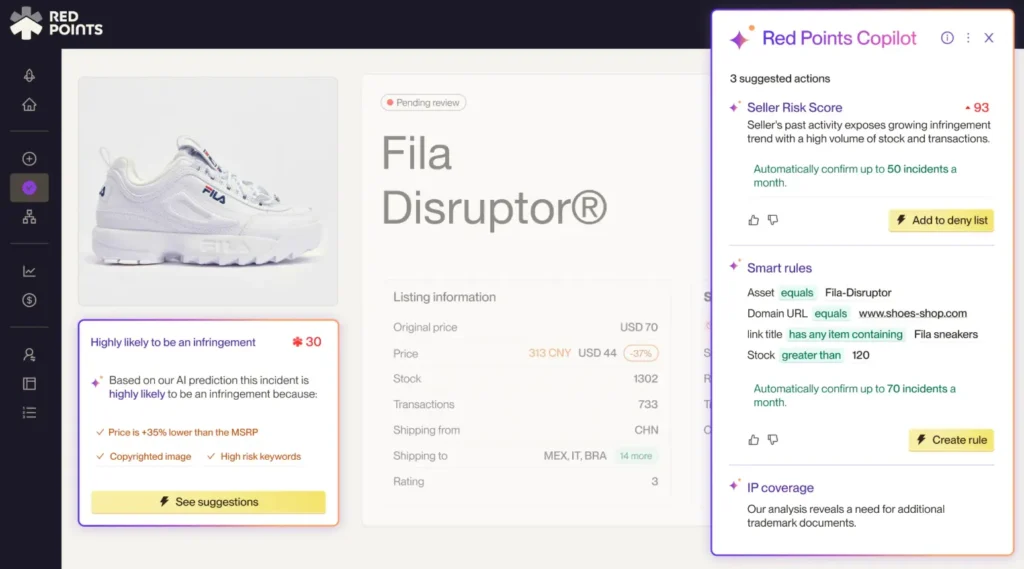
The first tool on the list is ours, Red Points.
Red Points combines operational maturity with scalable technology for consistent results and protection for brands of all sizes: SMEs (35% of its client base), mid-market (35% of its client base) companies, and large enterprises (30% of its client base).
While many brand protection companies offer AI integration, Red Points’ AI is trained on 2.7 billion risk data points every month, and a database of more than 50 million infringers. We integrate AI and automation (like incident prediction based on a brand’s history and seller risk score for high-risk seller prioritization) to make the process scalable, but have our experts control critical tasks, like enforcement push-back management or test purchases. Red Points customers can benefit from 24/7 detection and unlimited takedowns, which not all competitors offer.
Pros
- Largest online brand protection customer base in the market, with existing knowledge, playbooks, and trained data models for every industry and region
- Unlimited detections and takedowns (not capped nor limited by analyst hours), always-on
- Infringement confirmation can be done by the customer, via automation rules, by Red Points’ Service Excellence team, or by a combination of the aforementioned
- Coverage across all digital channels, including Domestic China marketplaces and social media (those not accessible from outside Mainland China)
- An enforcement team with more than 15 years of experience, priority escalation paths for complex cases and API connections for fast reporting
Cons
- Provides test purchases, but comprehensive offline investigations are offered through partners
- It can be more expensive than other brand protection providers
- Doesn’t offer trademark registration in-house, only through industry partners
Main features
Main features of Red Points include:
- Unlimited takedowns: Unlimited takedowns on marketplaces, websites, social media, domains, app stores, search engines, deep web, ads, AI shopping experiences, including fake sites blocked by region or device.
- Wide coverage: Counterfeit, impersonation, piracy, and gray market protection, plus domain management and social video protection.
- Intuitive dashboard: The dashboard provides granular information on infringement and seller trends and ROI.
- Revenue Recovery Program: A unique program to recover tangible revenue through high-scale, self-funded litigation and permanently disrupt hundreds of infringing sellers.
- Clear tracking: Real-time granular tracking of detected and enforced incidents, even after removal.
Pricing
Red Points uses a flat fee model that includes unlimited takedowns by channel. Plans come with an implementation manager and a customer success manager without an extra cost.
2. Corsearch
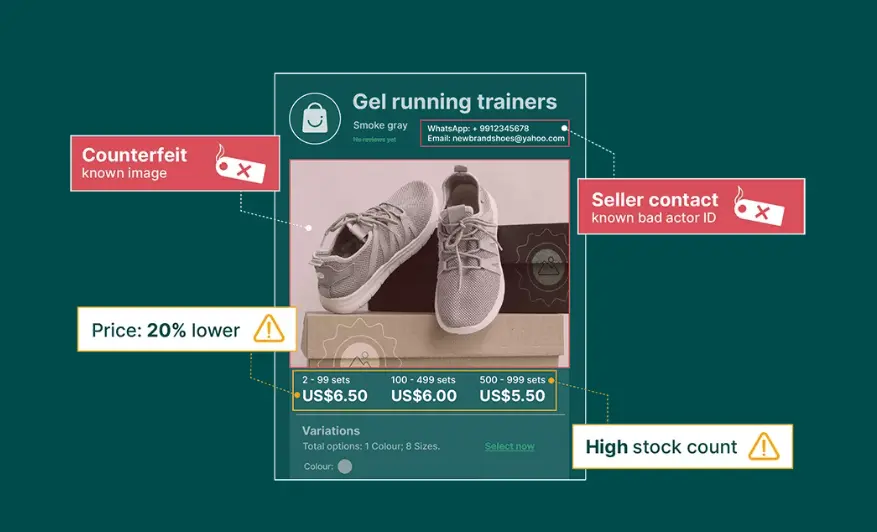
Founded in 1949, Corsearch offers full trademark lifecycle management, from registration to offline investigations and raids overseas, and it focuses on mid-market to enterprise companies. Corsearch traditionally operated with a service model instead of SaaS, so its packages and pricing are more dependent on analyst hours. Today, Corsearch offers Corsearch Zeal 2.0 as its AI-powered brand protection platform, the second version of its brand protection platform (the first was launched in 2024), which follows after the merger of several brand protection companies acquired in the last 5 years (YellowBP, PointerBP, Incropro, Navee).
Pros
- Good option for enterprise companies with large product catalogs, focusing on trademark protection and offline legal action
- Clients can change the scope of the work if the problem tends to move often from one region to another instead of expanding
- Offers a wide range of services (trademark registration, anti-counterfeiting, anti-piracy, offline investigations, etc.)
- Recently released a Revenue Recovery Program
- Can provide reports formatted to use in offline investigations
Cons
- Some public reviews raise concerns about enforcement disputes and alleged false-positive takedowns.
- Enforcement has caps depending on the number of review days or analyst hours consumed
- Relies more heavily on analyst-led workflows, which may limit scalability for some organizations
- Corsearch tends to be a bit more expensive than equivalent services because its model depends heavily on manual analyst work, which increases both cost and operational constraints.
Main features
Main features of Corsearch include:
- Trademark solutions: Screen potential trademarks, clear a trademark for viability, and monitor similar trademark registrations.
- Brand protection: Remove counterfeits, stop impersonation, and deter gray market sellers.
- Domain protection: Register and protect domain names from cybersquatting and misuse.
- Investigations 360: Coresearch can take offline action to stop counterfeiters through investigation, raids, and more.
- Anti-piracy: Protect books, games, digital content, and more from piracy.
Pricing
Corsearch has variable pricing depending on intelligence hours, analyst hours, package, and other criteria.
3. Marqvision
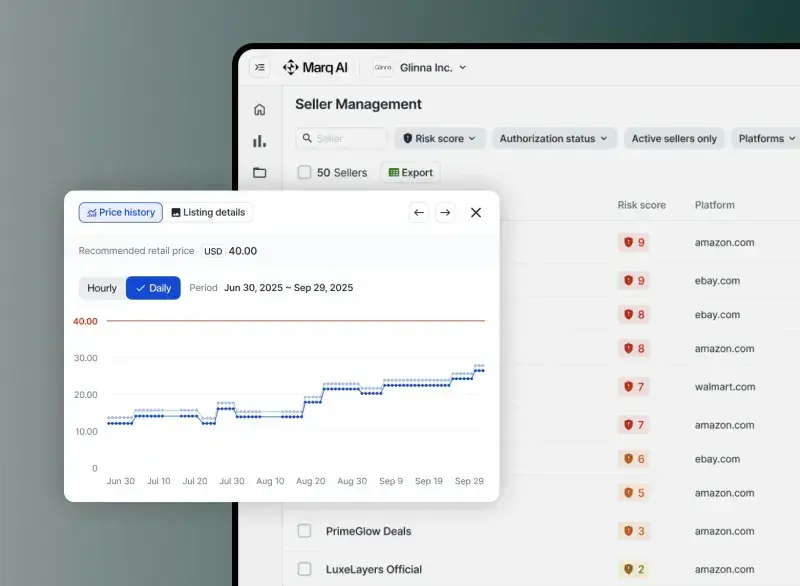
Marqvision is a fairly new brand protection company founded in 2020. They offer a suite of brand protection services to reduce counterfeits, impersonation, gray market sellers, and more. Marqvision removes fakes on over 1,500 marketplaces with a particular focus on Asia. It is currently missing coverage of some channels outside e-commerce, such as rogue apps. Besides brand protection, Marqvision also offers trademark services and offline support for investigations and litigation.
Pros
- Good variety of channel coverage and e-commerce in particular
- Provides domestic China coverage with investigative support
- Social media image protection is one of its strengths
- Can register, renew, and manage trademarks
- Can create smart rules to customize automated enforcement
Cons
- Missing channel coverage for fake apps
- Enforcement capacity may vary during peak periods, depending on plan limits and manual validation requirements
Main features
Main features of Marqvision include:
- Brand protection: Uses AI detection and clustering to remove fakes on marketplaces, social media, and standalone sites.
- Content protection: Protects images, software, videos etc. in search listings, social media, and more.
- Impersonation removal: Takes down fake websites, spoofed domains, phishing sites, and social profiles.
- Gray market visibility: Stops unauthorized sales and supports compliance.
- Trademark management: Register, manage, and monitor trademark IP.
- Offline services: Supports field investigation, raids, collaboration with law firms.
Pricing
Plan pricing depends on the number of detections and enforcements you want, though we’ve found Marqvision tends to be affordable.
4. BrandShield
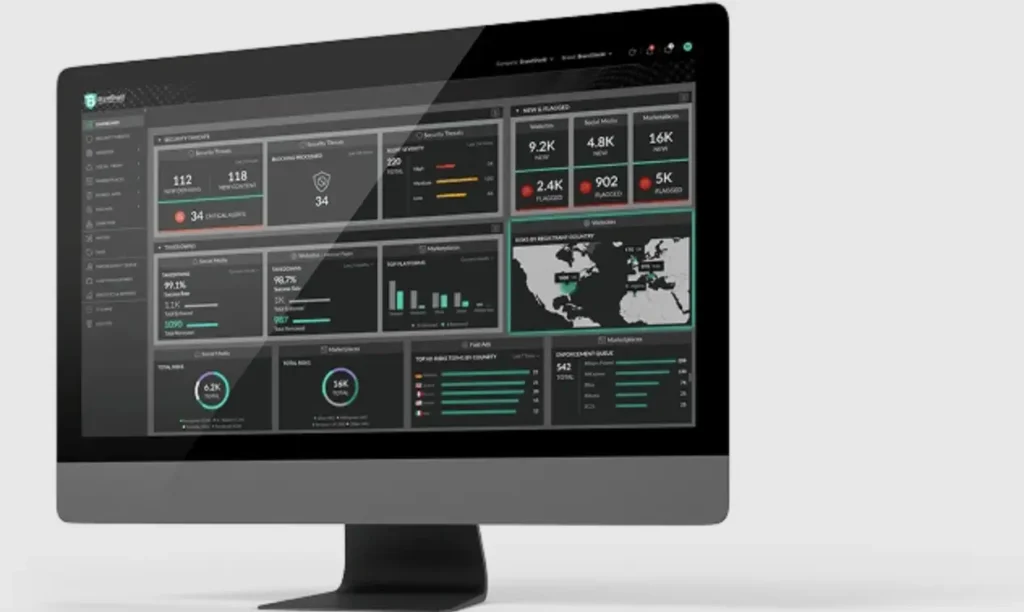
BrandShield is a brand protection platform with offices in Israel that has been in business since 2014. It offers a wide range of features, like protection against counterfeits, impersonation, phishing, and piracy. Specifically, it offers AI.ClusterX, which helps uncover networks of threat actors. This is integrated across the suite of services like trademark protection, phishing protection, counterfeit protection, and impersonation protection.
Pros:
- Covers websites, marketplaces, social media, ads, the dark web, and app stores
- Offers cybersecurity monitoring with BrandShield Resolve
- Dashboard works on mobile devices for on-the-go monitoring
- Tends to be an affordable brand protection option
Cons:
- Infringement scan frequency is limited depending on the plan
- Enforcement is capped by plan, which requires prioritization of threats. Doesn’t offer unlimited takedowns
- Services are sold in packs, so there is less flexibility in service and pricing customization compared to some other companies.
Main Features
Main features of BrandShield are:
- AI-powered detection: BrandShield’s system uses AI to detect counterfeits, phishing, piracy, lookalike domains, and gray market sales on a regular basis.
- Monitoring on marketplaces and social media: Track counterfeits, impersonation, and unauthorized sellers on Amazon, eBay, Instagram, Facebook, and more.
- BrandShield Resolve: The Resolve program provides external cybersecurity monitoring and takedowns through AI.
- Intelligence dashboards: See incidents, takedowns, and ROI of brand protection efforts in an online dashboard.
- Enforcement support: BrandShield provides an enforcement manager to help with complex takedowns and escalation.
- Wider brand threat monitoring: The platform can monitor the dark web, fake apps, paid ads, and cluster threats with AI.
Pricing
BrandShield pricing varies by the plan, and is often positioned as more affordable than the industry average, depending on service mix.
5. Bolster
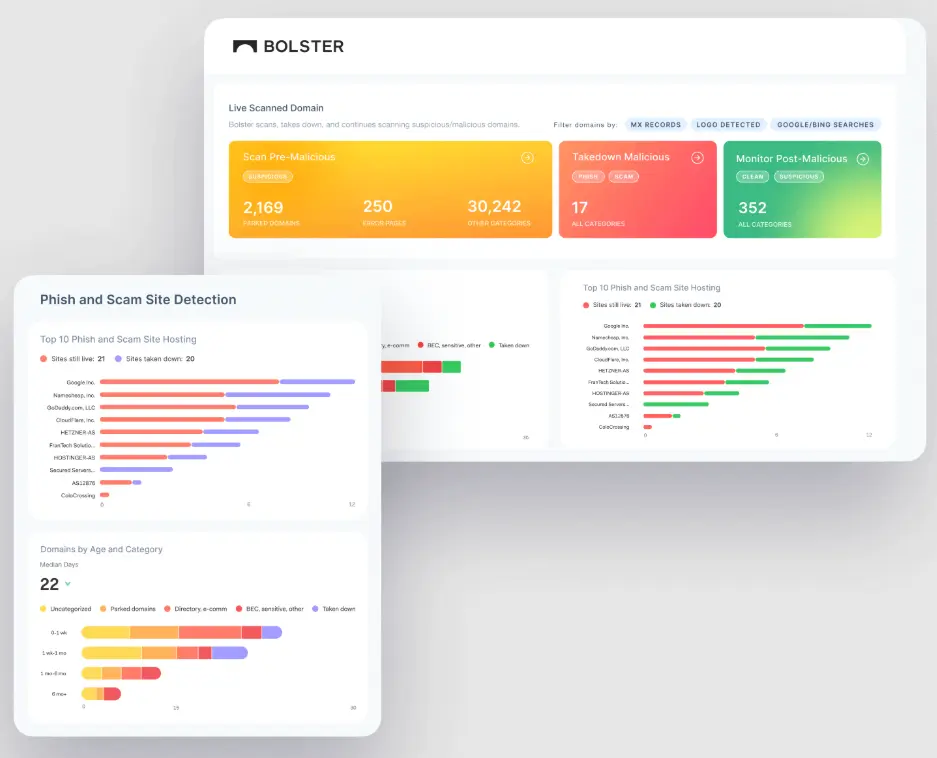
Bolster helps brands detect and remove phishing sites, brand impersonation, fake online stores, and lookalike or fraudulent domains. Bolster states an average takedown time of approximately 12 hours for phishing and impersonation incidents. However, Bolster doesn’t currently scan e-commerce sites. This means this is not the best option for companies that want to protect products on sites like Amazon or domestic Chinese e-commerce platforms. As a result, it is primarily suited for teams focused on scams, phishing, and brand impersonation rather than counterfeit product enforcement on marketplaces.
Pros
- Bolster states an average takedown time of approximately 12 hours for phishing and impersonation incidents
- Has industry partnerships with domain providers like GoDaddy and Namecheap
- Can use AI to uncover exposed credentials or phishing kits on the dark web
- Can implement automatic removals for phishing and impersonation
Cons
- Takedowns are capped and can require extra purchases once limits are hit
- No counterfeit takedown option for marketplaces yet
- Some channels require manual takedowns
Main features
The main features of Bolster include:
- AI phishing detection: Has advanced AI for detecting phishing and spoof pages.
- Monitoring and takedowns: Monitors domains, social media, and app stores to remove phishing and impersonation.
- Email security: Unique AI system for uncovering phishing in emails and crowd-sourcing customer insights for phishing detection.
- Risk scoring: AI provides risk scores for different infringements so you can prioritize action.
- Bolster Signals: A global threat intelligence feed provides insight into possible phishing and cybercrime incidents.
Pricing
Bolster offers a few different plans that vary by the number of annual takedowns, so what you pay influences how often you can enforce.
6. CSC

Having been around since 1899, Corporation Service Company (CSC) is a brand protection provider with a very long history. In fact, it does a lot more than brand protection, like domain security, DNS management, and digital fraud protection. Beyond risk management, CSC provides tax solutions, business entity formation, and more. Its brand protection program can cover a wide range of threats and channels, but it offers limited AI-driven automation compared to other companies.
Pros
- Offers a DomainSec dashboard featuring AI and clustering tools
- Strong domain security tools for enterprise companies
- Monitors fraudulent domain registrations, phishing, and impersonation worldwide
- Integrates domain security and brand protection in a single platform
Cons
- Not the best choice for small or mid-tier businesses
- Doesn’t offer an option to recover revenue through litigation
Main features
Main features of CSC include:
- Brand enforcement services: Monitors ISPs, registrars, social media sites, marketplaces, and app sites to remove scams and counterfeits.
- Domain security: Protects against domain infringement, DNS hijacking, DNS cache poisoning, DDoS attacks, and similar threats.
- Domain portfolio management: Can manage large portfolios of domains for enterprises.
- Includes team support: CSC team members work with digital tools to oversee enforcements.
- 3D Domain Security: This program provides a complete view of domain threats with daily alerts and weekly reports.
Pricing
CSC pricing depends on the scope, and it offers packages of digital service credits that can be used for different brand protection services.
7. OpSec
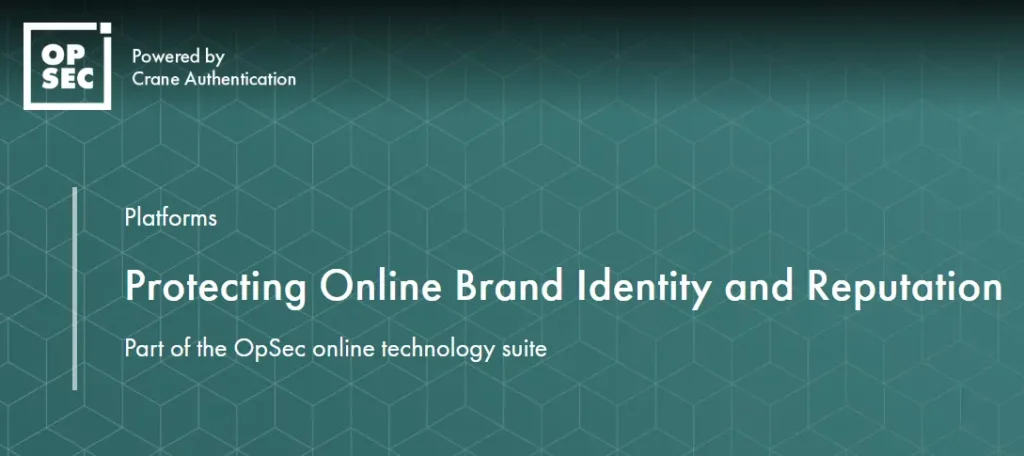
Rounding out our list of the best brand protection tools is OpSec Security. The company acquired MarkMonitor legacy brand protection capabilities from Clarivate Analytics, which had acquired MarkMonitor four years prior. OpSec itself has recently been acquired by Crane NXT. OpSec offers multiple services that are focused on enterprise clients. With OpSec, brands can fight counterfeits, manage their trademarks, maintain licensing compliance, and more. OpSec combines digital security with offline services like product traceability and authentication. In terms of its brand protection solution, it scans over 1,000 marketplaces and 30 social media sites a day.
Pros
- Broader cybersecurity offering
- Great for hybrid brand protection tools, with strong offline investigations capabilities
- Strong experience with enterprise clients and governmental agencies
- Monitors over 1,000 marketplaces and 30 social media sites
Cons
- Service offering might not match small or mid-sized company needs
- Onboarding and services may be too complex and long for smaller brands
- Cost is slightly higher than average
- Places greater emphasis on hybrid and offline services than on AI-first automation
Main features
Below are the main features of OpSec:
- Comprehensive detection: OpSec detects infringements on marketplaces, app stores, domains, social media, streaming sites, and more.
- Automated enforcement: Platform can remove infringements automatically at scale.
- IT security tool integration: OpSec intelligence can integrate inside existing company security tools.
- Visual AI: Visual AI helps spot fakes with logos, product images, and trademarked text.
- Early Warning System: The system reports on fraud and infringements daily.
Pricing
Pricing is typically positioned above the industry average, based on scope, enterprise focus, and service.
Disclaimer
This comparison is based on publicly available product documentation, vendor websites, and customer feedback shared during evaluations and reviews, as of December 2025. Capabilities, pricing models, and enforcement approaches may change over time.




